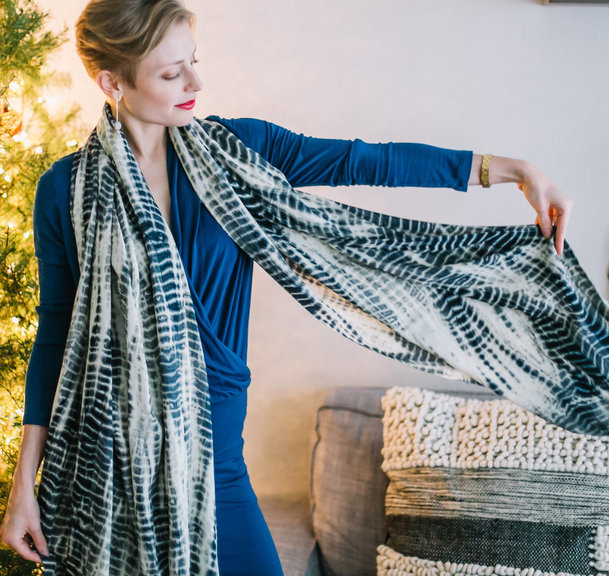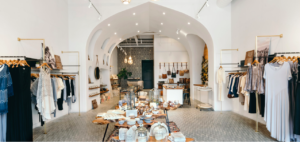While it’s is only a small part of the broader ethical movement, ‘artisan-made’ is often the appetizer that introduces consumers to an entree of issues. Like ‘organic’ is to ‘sustainable food,’ it both supports and pushes ethical fashion forward while sitting neatly underneath it with an array of other important and interconnected matters.
Artisan-made encourages us to ask more questions. It prompts us to learn that today’s commoditized and cheaply-made clothes have created an industry that masks grave human rights atrocities under layers of bureaucracy, corporate speak, and marketing.
Or, as is oft quoted, cheap clothes have a “true cost.” It’s the people who make them that pay it.
Today, for instance, you might be perusing a conventional store that doesn’t characterize itself as ‘ethical,’ but you’ll probably still come across the term on a hangtag or two. It’s gained recognition in the mainstream. I know this because 1. reading and 2. (most importantly) my 65-year-old dentist proudly called my attention to his artisan wall hanging during my last visit. This is, of course, is great news. But with it so “in vogue,” is it still synonymous with our ethics today? [/vc_column_text][/vc_column][/vc_row][vc_row][vc_column][vc_column_text]
Defining Artisan-Made
From indie makers to big-box retailers, brands put their own spin on the term. And no industry organization or foundation has stepped in to clarify a definition. Even Google can’t help. When I inquire: “What is artisan-made?” it spits out the generic word ‘artisan’ and defines it as a ‘craftsperson’. C’mon, Google. Step up your game!
By now, I’ve gotten comfortable with the undefined in ethical fashion. It’s our MO. We’re behind other industries when it comes to ethics and sustainability (okay, maybe not oil and coal). I get it. We’re all figuring it out and bootstrapping as we go. But I still think leaving ‘artisan-made’ undefined creates a black hole of confusion.
And that’s no good, especially today, since most of us are conditioned to expect convenience and cheap prices. It’s why we opt for easy brands like H&M who have marketed themselves cleverly, albeit dubiously, as ‘eco.’ If our clothes don’t make a clear and immediate case for ‘artisan-made’ or ‘ethical’, then forget it, we’re going with the cheaper option! This is the sweet spot where good intentions go down the toilet. Or, worse, where we get misled by brands that aren’t artisan-made at all.
And don’t we all know what happens when values aren’t agreed upon from the get-go? See the failed relationship parallel, anyone? Now, let’s puhhh-lease avoid that by getting to a definition! [/vc_column_text][/vc_column][/vc_row][vc_row][vc_column][vc_column_text]
How I See Things
To me, artisan-made implies that a brand is working directly with its makers to provide meaningful and sustainable work, preserving heritage craft traditions that would otherwise become obsolete, and compensating its workers fairly (wherever possible, above what the market dictates).
I feel like this is a pragmatic definition, but admittedly, I don’t have expertise in the artisan space. My bread and butter is sustainable fashion. I studied things like deep ecology and climate change and I’ve carried this into fashion through my research, writing, and speeches. I’m drawn to eco-fashion because it attempts to solve macro issues through systems thinking. Because who doesn’t want to tackle global challenges?
But the deeper I get in ethical fashion and meet people who are facing different chhead-ons head on, the more my perspective shifts. Yes, sustainability is critical, but the small small-scale change that doesn’t seem as “sexy” is just as important. It revitalizes communities, supports women in business and, best of all, its effects are direct and more immediate.[/vc_column_text][vc_single_image image=”3031″ img_size=”large” add_caption=”yes” alignment=”center”][vc_column_text]
Pictured in an artisan scarf from Bead & Reel.
[/vc_column_text][/vc_column][/vc_row][vc_row][vc_column][vc_column_text]How They See Things
So, sure, I have a newfound respect for artisan fashion, but I decided to bring in real experts. They’re the brands and businesses who are building relationships, navigating cultural nuances, and investing in long-term work that transforms lives. I spoke with my friend Jen Lewis of Purse & Clutch, an Austin-based, indie leather brand; Shivam Punjya of Behno, a luxury artisan line; and Sica Schmitz of Bead & Reel, an online ethical fashion boutique.
Today, they’re each carving their own paths in ethical fashion and collectively defining what ‘artisan-made’ means.
I began at the top by asking, “What does artisan-made mean to you?”
Jen (Purse & Clutch) told me she loves that it suggests the item is special in some way. “There’s an aspect of art to it,” she said. “Whether it’s leather, weaving, or botanical dying, there’s a legacy involved. Maybe a Mayan woman taught her daughter a craft skill and it’s been passed down in their family for generations.”
According to her, some artisans work this way, keeping skills within their families, and some don’t. For example, they may pick-up skills within their communities. However they learn their craft, it requires years of apprenticing. Ultimately, she thinks a way to distinguish ‘artisan-made’ is by asking whether or not a garment has an aspect of traditional art to it.
[/vc_column_text][/vc_column][/vc_row][vc_row][vc_column][vc_column_text]“Think of it like artisan cheese,” she said with a kidding-but-not chuckle. “If a garment is rooted in tradition, heritage, and involves slower, by-hand processes, it’s probably artisan-made.” – Jen Lewis, Purse & Clutch
Garment Workers Are Artisans Too
When Shivam (Behno) started working in fashion, he thought it meant “things that were handmade, woven, or embellished.” But after four years building his ethical line from the ground up, this evolved. Now, he wants to elevate the role of garment workers and expand it to include larger factories.
“The amount of work that goes into embroidering and embellishing garments with the level of consistency I see factory workers doing for us is incredible, he said. “To achieve the scale that they do, even for simple stitching, requires specialized training. I think we [consumers] reduce their work to something more simplistic.”
For Shivam, garment workers and artisans are one-in-the-same and he’s taking direct action to ensure they’re treated as such. Last year, he launched the #GarmenetWorkersProject, a bold visual and documentary campaign that aims to change the way garment workers are viewed, employed, and treated. In addition to storytelling, he also introduced a social initiative called the “behno Standard to take direct action. Next, he plans is to raise more awareness through a high-profile collaboration with Emma Watson (insert ethical fangirl swoon). [/vc_column_text][vc_single_image image=”3039″ img_size=”large” alignment=”center”][vc_column_text]
Portrait of Kalpana Rana, Dan Smith, 2016 for the Garment Worker Project. Kalpana is a line leader at MSA Ethos, a garment factory in rural Gujarat, India. This is a powerful position usually fulfilled by men.
[/vc_column_text][/vc_column][/vc_row][vc_row][vc_column][vc_column_text]Don’t confuse artisan-made with fair trade
Notably, Jen and Shivam approach artisan-made differently. Jen’s definition is more specific and deep, while Shivam’s is broad and sweeping. This lack of consensus isn’t rare and, like I mentioned, it makes things tricky for consumers. But, it turns out, ethical businesses also really struggle with the undefined too.
Take Sica’s marketplace for example. She has to make clear distinctions between labels like ‘fair trade’, ‘artisan-made’, ‘non-profit’, ‘gives back’, and ‘vegan’ when categorizing products. Mostly, she does this based on personal judgment and the values Bead & Reel champions. But she treats one label with particular care: fair trade. That’s because it’s the only one with certified and enforceable standards.[/vc_column_text][/vc_column][/vc_row][vc_row][vc_column][vc_column_text]“My intent in separating fair trade from a label like artisan-made is to distinguish but not diminish the brands that are doing equally valuable conscientious work around the world.” – Sica Schmitz, Bead & Reel[/vc_column_text][/vc_column][/vc_row][vc_row][vc_column][vc_column_text]
Why fair trade doesn’t work for indie brands
Allow me to unpack that. Becoming fair trade certified is rigorous and expensive. It’s why you see larger companies like Patagonia or, recently, Athleta with labels, more than indie ones. Big brands have robust teams and budgets to tackle certification requirements (and good for them for doing the extra work). Conversely, indie labels usually can’t afford certification. But that doesn’t mean they’re not equally amazing. They just need someone to shout from the mountaintops about them!
Sica is doing just that. Three years ago she launched the Fair Trade Fashion Show to give brands more exposure while supporting the ethical fashion community in LA and raising money for a non-profit (this year it was Free the Slaves).
“Another reason I put this on is to talk about the distinctions between all these ethical labels. I’m not sure every customer is digging around for this information. I think they kind of inherently trust us [brands /shops], which is awesome, but I also want them to understand the issues. Having the show is a fun way to inform that doesn’t force information.”
This educational element is critical because if a consumer trusts a brand like Bead & Reel they may shop on another ‘ethical’ site thinking they’re doing things similarly. However, that shop could be lying or greenwashing. Without distinctions, consumers get duped. [/vc_column_text][/vc_column][/vc_row][vc_row][vc_column][vc_separator][vc_column_text]
TL:DR Summary
Fair Trade is mainly for large-scale fashion brands that can afford rigorous audits and want a standardized and recognizable label on their products. It is also more widely-recognized and trusted by consumers. Conversely, artisan-made is smaller scale and more undefined. One is not necessarily better than the other, especially if artisan-made is done with thoughtfulness and transparency. And they are certainly on an equal standing ground when it comes to ethical importance. As you buy, assess each on a case-by-case basis, measuring them with different yardsticks. [/vc_column_text][vc_separator][/vc_column][/vc_row][vc_row][vc_column][vc_column_text]
Ensuring Artisan-Made
It’s about details
How can ‘true’ artisan brands make their case better?
“The main problem I see is if a brand says it’s ‘artisan-made’ that’s simply not enough,” Sica said. “They should have additional details on their pages and product descriptions that explain how.”
Personally, she has every brand on Bead & Reel sign a contract ensuring their standards. Then, she uses the information to write product descriptions that are engaging and simultaneously informative. Even with the attention to detail, Sica chooses to lead with images of her garments. They’re critical to attracting shoppers. Then, once they’re on the site, they can take a deeper dive into her ‘ethical report card.’ Additionally, and something I love about shopping on Bead & Reel, shoppers can ‘refine by ethic’, filtering through 15 categories to find a personal fit.[/vc_column_text][vc_single_image image=”3038″ img_size=”large” alignment=”center”][vc_column_text]
The perks of shopping on an artisan marketplace like Bead & Reel
[/vc_column_text][vc_column_text]It’s also about building relationships
So, the key to key to ensuring a garment is artisan-made for Sica is thorough documentation. Shivam takes a slightly different stance. He emphasizes relationships with his garment workers more. Logically speaking, their viewpoints make sense: marketplace: not as in touch with artisans, therefore must rely more on written agreements. Indie-brand: direct contact with artisans, therefore can take a more human-centric approach.
To produce the Behno line, for instance, Shivam personally visits his factories in Gujarat, India and takes time to learn the cultural nuances that lead to better product development.
[/vc_column_text][/vc_column][/vc_row][vc_row][vc_column][vc_column_text]“People may advertise artisan-made, but the litmus test is if they actually know them.” – Shivam Punjya, Behno
Bridging cultures
As a fellow self-run brand, Jen resonates with Shivam’s idea about relationships. She has long-standing ones with two different nonprofits in Ethiopia that produce leather for her line. One trains men in cutting and sewing, the other, teaches women the art of fine finishing.
“There’s a beautiful cultural sensitivity to their training as well. For the women, there’s a component of therapy and healing. The men are formerly homeless youth, so it’s about new pathways and building confidence.”
Similarly, Jen sources her cotton from multiple groups in Guatemala since each region has its own textile specialty. One co-op of women, for instance, hand spins raw cotton into thread and dyes it with botanicals. Two others weave in their community’s distinctive, indigenous style.
Jen works with artisans in both countries to refine the leather and cotton designs. Ultimately, she achieves a product that’s an amalgam of both cultures – one steeped in traditional heritage, the other, driven by the tastes of modern consumers.[/vc_column_text][vc_single_image image=”3035″ img_size=”large” alignment=”center”][vc_column_text]
Modern artisan design via Purse & Clutch
[/vc_column_text][/vc_column][/vc_row][vc_row][vc_column][vc_column_text]Going the Extra Mile
This considered approach is part of Jen’s core and her business.
“Part of me says we’re doing the best with what we have as a small brand. We go as far into the product cycle as we can. But we could always go further, do more. Right now, I don’t know exactly where the cotton comes from, so I’m fixated on remedying that.”
She is oft-quoted saying the Purse & Clutch tagline, “We choose to care how things are made.” This is certainly true and while it’s helped her turn out a marketable product in western markets (and one that’s especially popular in Austin), she often feels she pays a penalty for being more intentional.
“It can be frustrating when our prices are higher and people don’t understand the extra effort and vigilance we’re putting in.”
Competing on cost is a serious challenge for small and mid-sized artisan brands today. That, and it’s also significantly harder to put in the extra work she describes. So what gives? How can an artisan brand compete when there’s nothing stopping a less-than-thoughtful one from slapping an artisan-ish photo on their website and misleading consumers?
What happens when we’ve been sold a pipe-dream that, today, we can have it all? Cheap and artisan-made fashion. [/vc_column_text][vc_single_image image=”3036″ img_size=”large” alignment=”center”][vc_column_text]
Some of the Purse & Clutch artisans.
[/vc_column_text][/vc_column][/vc_row][vc_row][vc_column][vc_column_text]When photos go too far
You’ve probably seen tons of artisan-ish photos. They’re the ones that beckon you to rescue garment workers with your purchase. Instead of focusing on their craft, you get ‘poverty porn.’ Brands that do this are exploiting your emotions and, frankly, the workers themselves. But we’re getting smarter and realizing these photos do more harm than good.
Jen, Sica, and Shivam all agree that photos are the primary way brands communicate. That’s not changing. Instead of fighting it, they suggest looking for small nuances that indicate if a brand is truly artisan. Jen recommends looking at their social feed (Instagram) to see how the workers are portrayed. If you recognize the same photos being used by another ethical brand that’s a red flag. Another indicator is when a photo hasn’t been adapted to fit that brand’s style (i.e. it doesn’t fit their tone, color, fonts, etc.).
Since this advice, however, is mainly for indie brands. Know that things may look different when you shop on marketplaces. Their websites and social feeds may be more generic, and that’s okay, according to Sica. For her, it feels disingenuous to push artisan stories when she’s so far removed from the manufacturing and isn’t explicitly permissioned to use their photos. It’s a way of ‘staying in her lane,’ which is supporting artisans through buying and selling. [/vc_column_text][vc_single_image image=”3037″ img_size=”large” alignment=”center”][vc_column_text]
Behno’s photos are design-forward
[/vc_column_text][/vc_column][/vc_row][vc_row][vc_column][vc_separator][vc_column_text]TL:DR Summary
So as with disguising between labels, assess artisan brands’ photos on an individual basis with a discerning eye. Indie brands may take a more ‘human’ approach, depicting their artisans and telling their stories, whereas marketplaces may lead more with product photography. If you’re dubious, comment on their IG photo or email them.[/vc_column_text][vc_separator][/vc_column][/vc_row][vc_row][vc_column][vc_column_text]
An Endnote
With this piece, I am not on a quest to introduce a sweeping new definition of artisan-made. That’s the kind of work that takes years. Instead, my aim is to clarify how it’s defined today. In questioning three radically diverse and equally inspiring humans with artisan brands and businesses, I wanted to present the issues. Plus, I asked for their suggestions on how we, as purposeful consumers, can learn the signs of authentically artisan-made brands. From Jen, Sica, and Shivam, (oh, and me!) here they are:[/vc_column_text][/vc_column][/vc_row][vc_row][vc_column][vc_separator][vc_column_text]
Signifiers of Artisan-Made
A list of questions you can ask when assessing if a brand is artisan or not. I hope it helps, at least until the industry arrives at a clearer consensus.
- What is their price point? Tribal prints and Ikat get ripped off by stores like XXI and Target regularly. If it’s $15.99 it’s probably not authentic. If you’re on the hunt for value, scout out when ethical brands have bundles or sales. Start shifting to the mindset of “fewer, better things.”
- Do they share compelling stories? Artisan-brands should be all about their makers. If you’re buying from a marketplace they should have detailed brand descriptions. If it’s an indie label, you should see the faces and be able to read the stories of who made your clothes.
- Have you checked their social media feed? Look for the indicators like non-generic photos and on-brand visuals like Jen mentioned.
- Do they respond to you? If you email them do they write back in a way that doesn’t sound like it’s from a corporate playbook? Are they open about their practices? Keep in mind, they don’t have to be perfect but they should have at least one demonstrated area of expertise in artisan-made.
- Are they sold at conventional, big-box stores? Some brands, like Soko, have been successful selling in mass-market retailers like XXI and Nordstrom. But they are the exception, not the norm. Chances are if a brand is sold near a Claire’s it’s probably not artisan.
- Are they listed on ethical bloggers’ shopping pages? Try mine. Or consult others writers in networks like the EWC or The People Label. You can also check if these bloggers are wearing or writing about their garments.
- Are they part of ethical members organizations? Europe is a leader in this space, so they’re more organized. For those brands, you can check Ethical Fashion Forum. For the US and elsewhere, but consulting The Good Trade is always a ‘good’ first step.
- Does it actually look artisan-made? Go with your instinct here. You’ve got the knowledge deep down in your gut.
Do you have more you’d add to this list? And let me know your thoughts about artisan-made goods in the comments. Do you buy them? Why or why not?[/vc_column_text][/vc_column][/vc_row][vc_row][vc_column][vc_separator][vc_column_text]Scarf Bead & Reel, Dress Amour Vert.
Photos: Me Brandon Hill. All others brands’ own.
[/vc_column_text][/vc_column][/vc_row]



